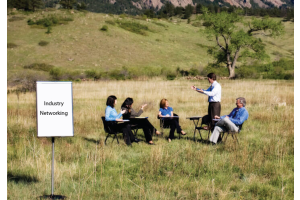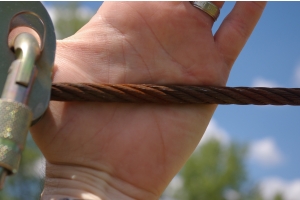zipline
-
August 02, 2020
Wire rope is a mainstay and central component of modern ropes course, challenge course and zip line installations. In teh ropes course and zipline industry we typically utalize flexible wire rope like 1/4" to 3/8" GAC (Galvanized Aircraft Cable)or IWRC (Independant wire rope core) in sizes up to 1". It's important for designers, installers, inspectors and operators to understand some basics on wire rope design and inspection.
Wire rope construction
Wire rope is made up of a number of individual wires that are twisted together. The wires can be made of a variety of materials, including steel, stainless steel, and aluminum. The type of material used will depend on the application. For example, steel wire rope is strong and durable, but it is also heavy. Stainless steel wire rope is corrosion resistant, but it is also more expensive than steel wire rope. Aluminum wire rope is lightweight, but it is not as strong as steel or stainless steel wire rope.
-
March 07, 2016
When it comes to ropes, there are two main types: dynamic and static. Dynamic ropes are designed to stretch, while static ropes are not. This difference in elasticity is what makes dynamic ropes ideal for climbing and challenge courses, while static ropes are better suited for other applications, such as rigging and securing loads.
Dynamic Ropes
Dynamic ropes are made from a variety of materials, including nylon, polyester, and Dyneema. They are designed to stretch when a load is applied, such as when a climber falls. This stretching absorbs the force of the fall, which helps to protect the climber from injury. Dynamic ropes are also more abrasion-resistant than static ropes, which makes them ideal for climbing on rough surfaces.
Static Ropes
Static ropes are not designed to stretch. They are made from materials that are strong and durable, such as nylon and polyester. Static ropes are ideal for applications where
-
May 03, 2015
Working at height is a common occurrence in the ropes course industry. Employees may be required to climb towers, traverse high ropes courses, or work on elevated platforms. As a result, it is important for employers to take steps to ensure the safety of their employees.
One of the most important things that employers can do is to ensure that their employees are properly trained in fall protection. Employees should be trained on how to use fall protection equipment, such as harnesses, lanyards, and lifelines. They should also be trained on how to recognize and avoid fall hazards.
Employers should also provide their employees with the proper personal protective equipment (PPE). This includes hard hats, safety glasses, gloves, and steel-toed boots. Employees should be required to wear this PPE at all times when working at height.
In addition to training and PPE, employers should also implement a fall protection plan. This plan should identify the fall hazards at the worksite








